On the rusty old trailer behind my car was NEWT, a 15′ solar-powered micro cruiser that would be my little floating home for the coming week. NEWT had proven herself last summer during a month-long cruise through Washington’s Puget Sound, among cities, restaurants, museums, and crowds of luxury yachts. This year, I was looking forward to a much more solitary and rural river trip in the Missouri Breaks National Monument. With NEWT in tow, I drove about 450 miles from my home in Saskatoon, Saskatchewan to get to the Missouri River. I stopped in Cadillac, a shadow of the boom times 80 years ago. Dilapidated buildings, wrecked cars, and an abandoned grain elevator slumber along a highway that runs from horizon to horizon through the yellow and green fields of grain. I was happy to get a tank of gas from the part-time station proprietor/farmer wearing a John Deere hat.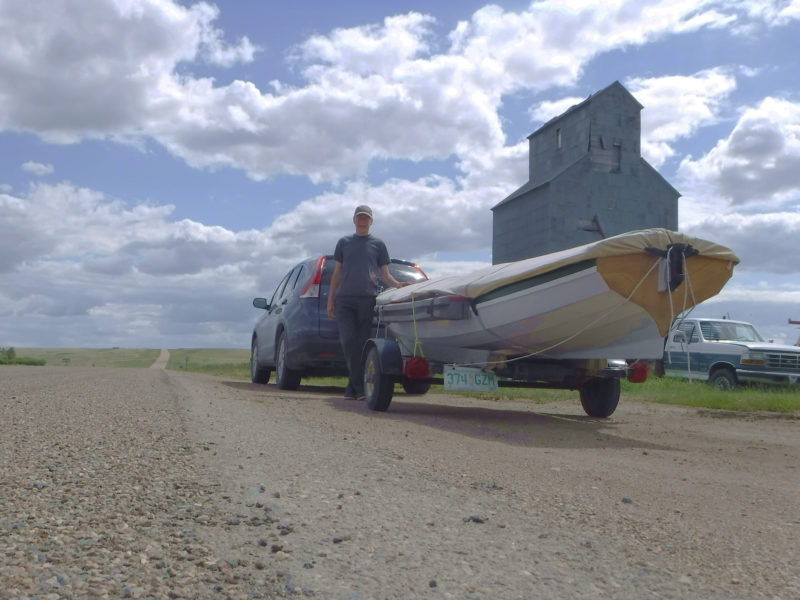 All photographs by the author
All photographs by the author
Join The Conversation
We welcome your comments about this article. To include a photo with your remarks, click Choose File below the Comment box.

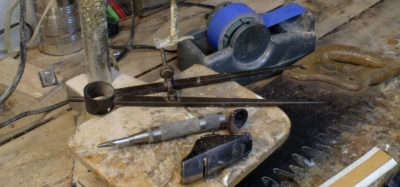
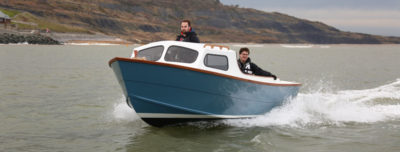
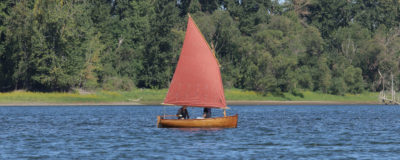
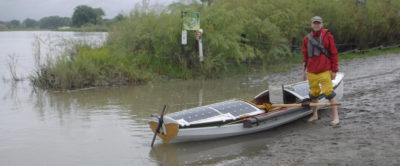
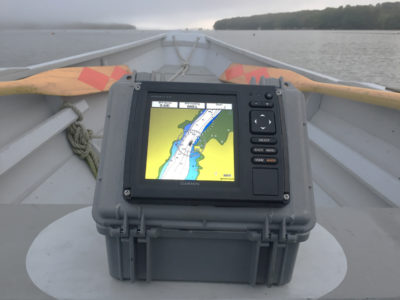
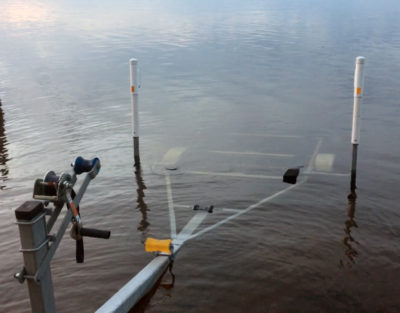



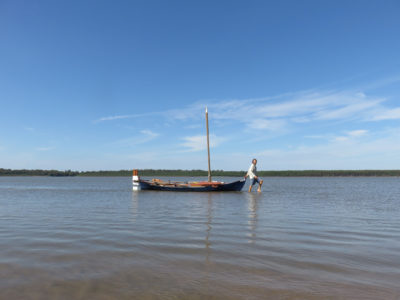
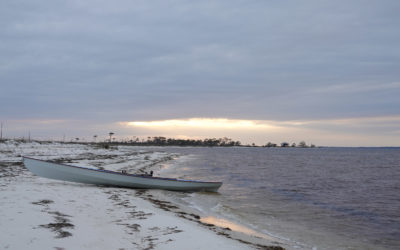
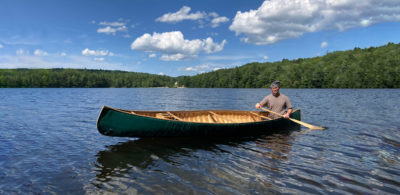
Rick, I’ve kayaked that stretch of river and it is truly gorgeous and wild. I admire the performance of your NEWT—that turn of speed and efficiency is something I’ve not heard of in a solar boat. Please keep us informed of your further developments in solar marine propulsion!
Thanks, it was a great trip. Especially because of the flooding there was nobody else there. Very lonely. The hull is very easily driven, and I have lots of solar. That’s a good combination.
Rick:
It’s likely that many boaters have been intrigued by your account but few “enjoyed” it. Too many of us have shared your frustration of pushing on when cold and wet, miserable for the foreseeable. Not all voyages are larks.
All of us were surely fascinated by your solar propulsion but you haven’t given us enough description of how your rig handled. Did it perform to your expectations? May we assume that NEWT is a work in progress? Was is possible to clear the propeller from the cockpit? Did your cells and batteries provide more than the boiled water?
We’re all focused on small boats and their performance, yes, but how much did you engineer NEWT for your own comfort? Comfort isn’t dismissible as a design factor. Indeed, it’s a safety issue: miserable skippers make unsound decisions in the moment. I’m assuming that this was a shakedown run, and none of us can predict the weather for time we’ve planned in advance. But we can predict the chance of bad weather and its consequences. If you had foreseen steady cold rain, how would you have engineered your “pilot house?”
Not to diminish your achievements in finishing this float! You adapted and endured. Beside and beyond that, should we consider real comfort as a viable, important design factor in small boats? Might we agree that dry, warm and well-protected skippers are less distracted? This isn’t about you, Rick, but about a kind of tough-guy, I-can-take-it, Spartan ethic of small-boat design. Truth to tell, I don’t admire the Spartans.
Your use of the wand-rigged camping tent over your cockpit was apt. Those wands have been ingeniously used as design components for decades. Would you have been more comfortable and would you have enjoyed the fascinating banks of the Missouri more beneath a wand-curved light bimini? I’ve honestly enjoyed rainstorms sitting dry beneath the bimini of a bigger boat. That our boats are small doesn’t demand discomfort. Might we encourage small boat design that ensures a dry, rain- and sun-shielded conning seat? Or are small boats only for Spartans?
Adkins
Thanks for the insights. Yes, comfort is an issue. This was certainly not optimized for comfort. I’m thinking maybe a larger version of this is in order. I’ve had this out for two seasons. Last year I spent a month on Puget Sound. A lot more ambitious trip, much more urban and open. Less lonely. I did have a small tarp that I would place over the tent structure for sunny afternoons. That worked well. The solar panels provided all of the power. For propulsion, cooking, lights and charging devices. I’m busy developing a commercial version of the solar panels used here. Optimized for high performance lightweight applications like this. You can track this at http://www.lightleafsolar.com.
The Angus Rowboats RowCruiser might be a better starting point for a solar expedition boat. Cabin/sleeping accommodations is built into the forward section of the hull – no tenting required. There is plenty of deck space for solar panels, and enough transom to permit mounting an electric trolling motor, plus you have sliding seat rowing as alternative propulsion, and a way to get some exercise on a longer trip.
Yes, I’ve identified this as maybe the next version. I’ve been talking to Colin about this, but he is currently busy with his antonymous boats right now. The Angus boat is slightly larger, slightly bigger on the beam, lots of room for solar panels. I’ve been thinking of producing a solar conversion kit for this type of boat. I think there are a lot of folks like me, a bit older and not thrilled about rowing six hours a day. But still needing to get out there and adventure.
Hey Rick, very cool! It sounds like it was quite an adventure. What a neat little boat. I have a small solar-powered boat too. It has a 2-stage variable-speed engine that relies on dispersed soil-based chlorophyll inverters that transform sunlight to chemical energy, then I supply mitochondria to convert stored carbohydrates into paddle strokes.
Good morning Cathy. It’s good to hear from you. I just had lunch with Gord the other day. Big changes coming in their life in the next year or so. Yes, I used to have a system like that, but it is getting older and not working as efficiently. Also, it’s tough to paddle while you’re eating cheeses and drinking tea. When it comes right down to it, I’m just a lazy bum. I spent a month in the boat last year in Puget Sound. I remember passing a group of kayakers (I go slightly faster than the typical kayaker paddles). I waved as I went by. Feeling kinda guilty. You folks still getting out and paddling much these days? I’ve taken a leave of absence from the University and I’m developing a new kind of solar panel that is really good for these high performance lightweight applications.
Harassed by a band of wayward marauding cows! Who knew? Great story. Thank you.
Brad, I just took a look at this article and noticed some comments. Thanks for the compliment.
This summer, I’m planning on building a solar-powered bike camper and hitting through the mountains.
Rick,
That’s really a nice boat.
Twenty five years ago my family and another family floated in five rented canoes from Ft. Benton to the James Kipp area where US highway 191 crosses the river just above the Fort Peck reservoir, about three days on beyond Judith Landing. Your pictures brought back great memories.
During the seven days, we saw only one other canoe (briefly, taking out at Coal Banks as we went by), two cowboys riding along the river, and a B-1 bomber that flew low over us at dusk one evening, with afterburners on. Really loud. Scared us to death, because you couldn’t hear it coming. Not another soul. Almost no cattle. No dirt roads or even Jeep tracks along the river, and no campgrounds except at Judith Landing. Ancient tepee rings and wild horses up on the bluffs in several places. From your pictures and descriptions, it looks a little more “built up” today, though obviously still pretty wild. We rarely paddled except to go ashore to fix lunch and to spend the night. Sleeping and eating ashore was comfortable, but you did have to check for rattlesnakes.
I’ve built several canoes and kayaks, and understand the desire to use what you’ve built. But for us, the rented canoes and sleeping comfortably ashore were fine.
I hope you continue to work on the solar power as batteries become cheaper with more capacity. Freeing up some deck space and interior volume sounds like it would be very helpful.
Rich Wagner
Rich, I just took a look at this article and noticed some comments. Thanks for the compliment.
Very well written adventure story, Rick. Fantastic descriptives.
I see your business is selling the solar panels. I would really like to read an Instructable on the ‘motorboat’ conversion process.